![]()
2020: The State of the .40S&W Cartridge
And Why Ballistics Haven't Changed
by Mark Eric Freburg
Not everyone may be be aware that the .40S&W as a cartridge has actually taken several steps backward in popularity over the last few of years. But let's analyze why, and whether this has much importance in the grand scheme of things. While I've talked about the lessening of popularity for the .40S&W cartridge on this forum's message board for the last couple of years, I decided to gather my thoughts, opinions, as well as the facts and put them all in one place. I'm including a good bit of discussion of terminal ballistics, and for an important reason. There is currently a belief circulating that the 9mm is as good a cartridge as the .40 or .45 or anything else you may choose for self-defense. While there is some truth to the idea that with the right ammunition, most service calibers can do the job, this belief has unfortunately gone a step too far, with people who should know better now believing--and preaching--that the 9mm is the best cartridge out there.
What you must understand is that "best" is subjective. What is best is what is best for you. Other than that, there is no best cartridge.
If you own or are issued a .40S&W handgun, the cartridge under discussion today, I am going to reassure you with facts that you are not in any way, shape, or form undergunned. You may in fact be better off.
Now then, prior to writing this, I decided to see what others had to say on the subject of the loss in popularity of the .40, so I checked the Internet. I read columns from several firearms blogs as well as visited appropriate major web sites, to include checking the the editor of NRA's American Rifleman Magazine's Internet column. It seems everyone has their own ideas about the .40, and everyone has done a variety of research, some more than others. NRA Editor Keefe talked to gun manufacturers. One blogger talked to several gun shops in his home town. ![]() And we've got all kinds of "research" in between those two extremes. Most didn't really seem to care about much more than "the .40S&W isn't very popular anymore." But then, popularity is all that some people ever care about. Hopefully you are not one of them.
And we've got all kinds of "research" in between those two extremes. Most didn't really seem to care about much more than "the .40S&W isn't very popular anymore." But then, popularity is all that some people ever care about. Hopefully you are not one of them.
 Most people view the fact that the FBI very publicly reverted to the 9mm and made it clear they believed the 9mm to be sufficiently as effective as other service cartridges as the primary reason the .40S&W began a downward slide in popularity.1 Whatever the Bureau does, American law enforcement has a tendency to follow, and from there, private citizens often follow as well. It is a fact that many US law enforcement agencies have switched from .40S&W sidearms to 9mm. The FBI's pronouncement on caliber effectiveness is not the only reason, but it is one of the two major reasons for this change.
Most people view the fact that the FBI very publicly reverted to the 9mm and made it clear they believed the 9mm to be sufficiently as effective as other service cartridges as the primary reason the .40S&W began a downward slide in popularity.1 Whatever the Bureau does, American law enforcement has a tendency to follow, and from there, private citizens often follow as well. It is a fact that many US law enforcement agencies have switched from .40S&W sidearms to 9mm. The FBI's pronouncement on caliber effectiveness is not the only reason, but it is one of the two major reasons for this change.
Let's examine that one first. The FBI declared rather loudly, because they are after all the FBI and anything they do is loud, publicity-wise, that the 9mm--in certain loadings, though most everyone ignored "in certain loadings" part--outperformed "most" .40 and .45 loads--that the FBI has tested. Again, the FBI added a qualification of "most" .40 and .45 loads, to their commentary. They also said their was "little to no" difference in wound tracks from 9mm through .45. "Little to no" I interpret to mean--wait, I don't interpret that at all. I take it to mean just what the FBI said: "little to no." That is not the same as none. Note the FBI didn't carefully quantify what they meant. They used no scientific terminology in their report. On the other hand, leagues of 9mm fans across the nation dropped the "little" and decided the FBI meant "no difference at all." After all, the FBI was adopting the 9mm, that was enough. Frankly, I suspect the FBI said what they meant to say--enough and no more. Be careful with private interpretation. It's easy to ignore physics.
The reality is that you simply cannot discount caliber. (And remember with caliber you get increased bullet weight.) Apologists say caliber is a small difference, with the emphasis on "small." Emphasize it however you choose, but the fact is there is a difference: a bigger hole is a bigger hole, and if you start bigger you end up bigger.. Bullets will only expand so much across the board. However, and please note this carefully--I'm not going the other direction and saying that caliber is everything because it isn't. You won't hear me make ignorant statements like "all else being the same, larger caliber is better," because all else is never the same. Different caliber cartridges work in different ways to incapacitate bad guys. Only the ignorant look at only caliber, or only velocity, or only energy figures, or only momentum, etc. If we are to understand anything about self-defense or law enforcement ammo, it is that there are simply too many variables to make simplistic comments about caliber as if caliber is all that is important. Caliber has not been of over-riding importance since our only slugs were solid lead and our only propellant was black powder. Of course the same applies to velocity or energy or other single pet feature you might believe in. Nothing is of over-reaching importance--but it all works together. Different cartridges succeed or fail based on different parameters. One has a little more diameter, one has a little more velocity, one has a little more this or a little more that--and these features are not directly comparable. But what they all produce--if they are successful--is meaningful 12" to 18" of penetration and significant expansion. This can be be predicted by testing in ballistic gelatin, as shown below:
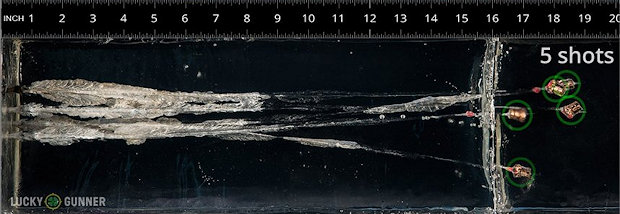
Is it a perfect test medium? No, gelatin is homogeneous and human bodies are not, but it is the best we have. Street results may be interesting but will never be a good prediction of so-called "stopping power" because there are too many variables when it comes to shooting human beings, not the least of which are psychological, not to mention the difficulty in determining the results of multiple rounds fired into a single target that struck vastly different body structures. Don't let so-called "stopping power studies" sway you. The only intelligent way we can compare loads of different calibers is via bullet expansion and fired bullet diameter in a consistent test medium. Gelatin testing is consistent and repeatable. Penetration and expansion is all that matters when it comes to stopping violent attackers--not velocity, not energy numbers, not anything else.2
What is important about penetration and expansion? Understand that bullets work by damaging internal organs and tissue. When a bullet enters a body it begins to expand at a pre-determined rate to greater than its initial diameter. It creates a wound path, called the permanent wound cavity, where it damages or destroys everything in its path by tearing a hole. The greater the bullet's diameter the greater the damage. And the further it penetrates the more tissue is damaged--short of through and through penetration of course, which is not desired. You should also be aware that in conjunction with the passing of the handgun bullet there occurs something called the "temporary wound cavity." This "wound cavity" is somewhat misnamed because it not only rarely wounds, but it is temporary, and most human tissue reverts to normal after being stretched by the passing of the handgun bullet. This temporary cavity is nothing more than a low energy wave--note it is not a shock wave as some might imagine it. Only the most fragile tissue can be damaged by the "temporary wound cavity," such as the liver or pancreas, which are quite delicate. So while most wound ballisticians today dismiss the temporary cavity as almost useless in the wounding process, it can under some very few circumstances do damage--but very few.3 The problem is that the temporary cavity APPEARS permanent in gelatin testing because gelatin is not elastic like flesh, and thus amateurs are often impressed by its appearance. Don't be. All that truly matters is the permanent wound cavity--that it is the hole that does damage.
So--you cannot discard original caliber because in the end, expanded bullet diameter counts for something, and is based on original bullet diameter. Consider that your shot may come close to an important organ or blood vessel, or that you may actually rupture it--simply because your expanded bullet is half again larger than someone else's chosen bullet. Again, it is a small thing in the order of likelihood, but it is nonetheless a possible advantage. To that end, since it can be proven, and has been, via gelatin testing, that good loads exist in all service calibers, small advantages in bullet diameter are actually a plus, not a minus. Bigger bullets are also heavier, and momentum can be another small thing that aids penetration. Since a .40S&W cartridge starts off at forty caliber, it already has a small advantage over the .35 caliber 9mm. In order to be more effective than the 9mm, the forty in a comparable bullet design with comparable penetration and a greater expanded bullet diameter can perform the same or better than a 9mm. Many such .40S&W loads clearly exist. These Federal 155gr Tactical Bonded bullets, fired into test gelatin, are just one of dozens of examples of good .40S&W loads that penetrate to the FBI's required standards and expand properly:
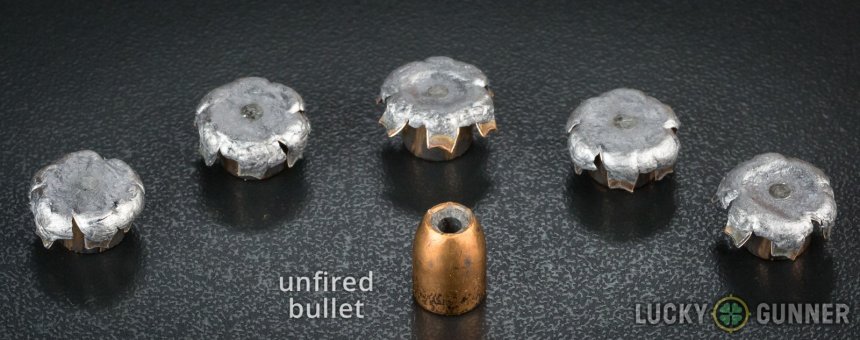
So why have so many agencies and individuals moved away from the .40S&W and back to the 9mm? I've been discussing one reason why so many people have moved away from it. It started with the FBI, but the FBI's caliber pronouncements were only half of it, and a thinking man or woman can make a cartridge choice independently of the FBI, especially because the FBI's pronouncements were somewhat misinterpreted by most of the tactical community--hopefully that is clear. But what is the other half?
The other reason is that FBI agents especially, and police officers in general, are usually not shooters when they join their organizations. Both the FBI and police departments across the country found that the qualifying of agents/officers with .40S&W pistols was, for some, too difficult. .40S&W pistols are, in the main, rechambered 9mms in terms of size and weight. Failures to qualify were common. Cops that can't qualify are a bad thing. Using limited resources of time and money to constantly reshoot until qualification is accomplished is a bad thing. But the worst thing is that having officers on the street who are poor shots (ultimately "qualifying" or not) is simply scary for the public, or should be. According to the FBI, 70-80% of ALL law enforcement rounds fired on the street (as stated in their 2014 report linked at the bottom) MISS their targets. But as with cartridge effectiveness, you as an individual are free to choose a gun/cartridge apart from any agency dictates, and adopt both the firearm(s) and the cartridge that works best for you. If you find a 9mm the easiest handgun to shoot, go for it, but if you like the .40S&W and shoot one well, there should be nothing stopping you from choosing one, or to continue to use one if you've been using one all along. It is still a very effective self-defense cartridge. If you doubt it, check out the ballistic gelatin testing done with a multitude of .40S&W rounds by Lucky Gunner Labs.4
So while some law enforcement is no doubt moving to the 9mm, it's partly because they have bought into the idea that there is "essentially" no difference between all popular service loads, a concept which the FBI--on purpose or accidentally--helped perpetuate, and partly because the nature of police officers today is that many of them simply are not shooters and cannot handle--and don't take the personal time to practice--to learn to handle the increased recoil and snappiness of the .40S&W chambered service pistol. (An aside here--I'm personal friends with several officers who, as you'd expect, are indeed shooters and can handle any caliber firearm you'd care to hand them. But they are good shooters because they choose to be, not because their agency made them a good shooter. Most agencies today are strapped by both time and budget, and thus the easy-to-shoot 9mm is better for THOSE AGENCIES than the harder-to-shoot .40--or .45. But this should have nothing to do with the private armed citizen who can choose for himself/herself and make his/her own time to practice.)
Where does that leave the .40S&W cartridge? There is good news and bad news.
For fans of the round, or fans of cartridge variety, police use meant widespread 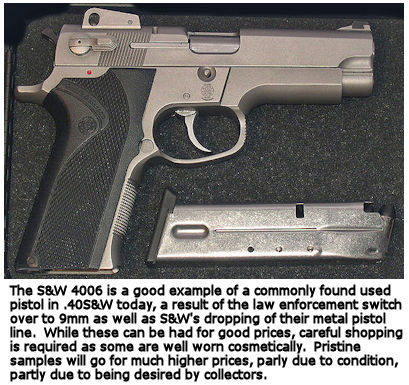 variety in terms of both .40-chambered guns and .40S&W loads. At one time in America we had more .40S&W pistols in police holsters than any other round. It is now reverting to the 9mm again--not because the 9mm is better but more because of the domino effect, I believe--and surplus .40S&W pistols are everywhere on the used gun market, especially Glocks and Smith & Wesson M&Ps. Most of these will run forever and they are easily rebuilt as parts wear. That is a definite plus if you want to acquire a .40S&W chambered pistol, though if you want something other than a Glock or M&P, shop carefully. Some brands are more expensive than others, especially if they also fit in a collector's niche, such as older S&W third generation autos.
variety in terms of both .40-chambered guns and .40S&W loads. At one time in America we had more .40S&W pistols in police holsters than any other round. It is now reverting to the 9mm again--not because the 9mm is better but more because of the domino effect, I believe--and surplus .40S&W pistols are everywhere on the used gun market, especially Glocks and Smith & Wesson M&Ps. Most of these will run forever and they are easily rebuilt as parts wear. That is a definite plus if you want to acquire a .40S&W chambered pistol, though if you want something other than a Glock or M&P, shop carefully. Some brands are more expensive than others, especially if they also fit in a collector's niche, such as older S&W third generation autos.
On the minus side, many brand new guns are coming out chambered for 9mm, sometimes with a .45ACP version, but without a .40S&W version offered, or even planned. In his column, NRA Editor Keefe mentioned that he was told by some gun makers that they planned only to offer new pistols in 9mm unless customers asked for .40S&Ws--in which case they'd build forties. Nothing new about the dollar driving production. Oh, plenty of new .40s are still available, but the variety is diminishing. The newest and most modern law enforcement and self-defense pistols are 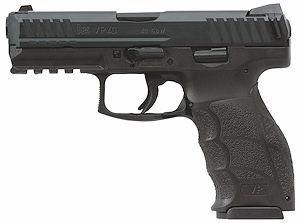 usually not offered in .40, apparently, at least not right away. In fact it seems it was actually a surprise to many when H&K came out with the VP40, shown at right, one of the few new, cutting edge polymer, striker-fired pistols in .40S&W, some time after their VP9 hit the streets. But the fact that a .40 showed at all did surprise many simply reinforces the fact that the .40 cartridge is no longer as popular as it once was. A dozen years ago the .40 versions of popular pistols were often the first ones released, not seen as an afterthought. Change, for sure.
usually not offered in .40, apparently, at least not right away. In fact it seems it was actually a surprise to many when H&K came out with the VP40, shown at right, one of the few new, cutting edge polymer, striker-fired pistols in .40S&W, some time after their VP9 hit the streets. But the fact that a .40 showed at all did surprise many simply reinforces the fact that the .40 cartridge is no longer as popular as it once was. A dozen years ago the .40 versions of popular pistols were often the first ones released, not seen as an afterthought. Change, for sure.
So does any of that mean that choosing the .40S&W is, actually, a poor idea? No, absolutely not. Just because of a big draw-down in police use does not mean that the .40S&W is dead or even dying, despite the videos on You Tube proclaiming just that. It clearly lacks the huge popularity it once had, but it is not going away. Guns will be made. Consider that if you want one you can still buy a pistol in far less mainstream chamberings like the .357SIG, .38 Super or .41 Magnum, all three less popular than the .40S&W these days. The idea that .40S&W pistols are going to disappear anytime soon seems delusional. It's not exactly the .45GAP.
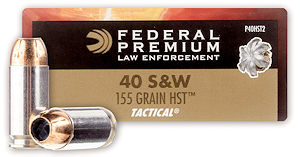 How about .40S&W ammunition? The answer is "no" there as well. It will not be like a few years ago when the very first new load for any company came out in .40S&W, but as an armed citizen that should not concern you. Rest assured .40 loads will be forthcoming along with all the other major calibers. Besides, anyone with his thinking cap on is going to want to see some testing of new loads before doing any personal adopting--so what if .40 isn't the very first load when a new bullet appears? Right now, years into the .40S&W draw-down, a quick look at Ammoseek.com will show there are still multitudes of just online dealers selling a huge variety of .40S&W loads. And it's still dead common in brick and mortar gun stores as well.
How about .40S&W ammunition? The answer is "no" there as well. It will not be like a few years ago when the very first new load for any company came out in .40S&W, but as an armed citizen that should not concern you. Rest assured .40 loads will be forthcoming along with all the other major calibers. Besides, anyone with his thinking cap on is going to want to see some testing of new loads before doing any personal adopting--so what if .40 isn't the very first load when a new bullet appears? Right now, years into the .40S&W draw-down, a quick look at Ammoseek.com will show there are still multitudes of just online dealers selling a huge variety of .40S&W loads. And it's still dead common in brick and mortar gun stores as well.
If you are a .40S&W fan you are not alone. There are still thousands of police departments carrying .40S&W pistols, despite the great change back to the 9mm by many high profile departments. This ensures the .40 ammunition stream will continue. And there are still thousands upon thousands of armed citizens who prefer the .40S&W over either the 9mm or the .45ACP, itself considered by some a slightly fading light these days (but that is a story for another day). The thing to remember is that you should not panic when everyone from your firearms instructor to the guy behind the gun counter to the You-Tuber who has been into guns for a week tells you the .40S&W is dead. It has taken a downturn, absolutely--but it certainly is NOT dead.
If you're a fan, enjoy not being one of the crowd who has gone with the 9mm. Or you can be like some of us and own and enjoy guns chambered for all of these different cartridges. No one said you have to choose just one.
NOTES:
1 See Terminal Ballistic Realities for a copy of FBI 9MM Justification, FBI Training Division, dated 2014.
2 Other cartridge features must be considered for purposes of recoil control (speed of shooting), reliability in one's firearm, accuracy, etc., but not for effectiveness on an attacker.
3 Please understand we are talking the wounding mechanisms of handgun bullets only in this article. With rifle bullets, at considerably higher velocities, the temporary cavity may add to the wounding process, because it causes hydrostatic, or hydraulic shock, a remote wounding and incapacitating effect in living targets through a hydraulic effect in their liquid-filled tissues, in addition to local effects in tissue caused by direct impact, the permanent.wound cavity. At best hydrostatic shock may be devastating, at worst it may simply increase the diameter of the wound channel significantly. Hydrostatic shock is not universally accepted in the wound ballistics community and is outside the scope of this article. As it is generally considered to require a bullet impact velocity of over 2000 feet per second to take effect, it clearly only applies to rifle bullet wounds, thus my comments on the ineffectiveness of the temporary cavity in wounding with handgun bullets holds true.
4 Lucky Gunner Labs .40S&W Ballistic Gelatin Testing

Uploaded: 1/8/2020

